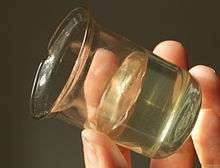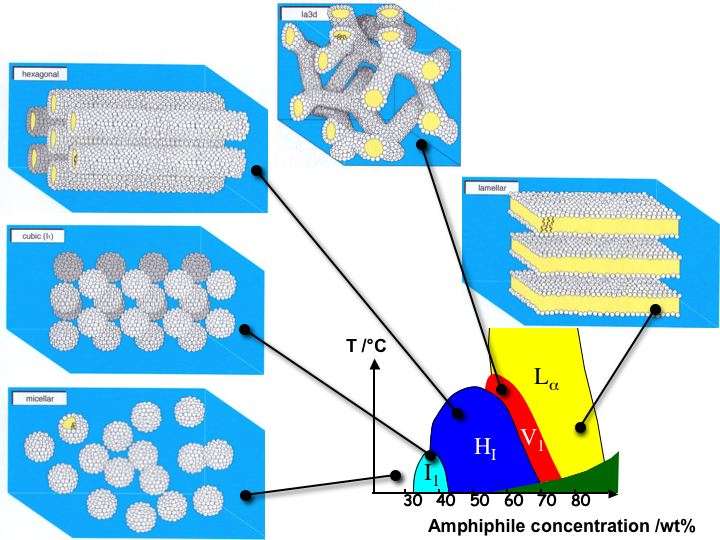Lyotropic liquid crystal

A liquid crystalline material is called lyotropic if phases having long-ranged orientational order are induced by the addition of a solvent. Historically the term was used to describe materials composed of amphiphilic molecules. Such molecules comprise a water-loving 'hydrophilic' head-group (which may be ionic or non-ionic) attached to a water-hating 'hydrophobic' group. Typical hydrophobic groups are saturated or unsaturated hydrocarbon chains. Examples of amphiphilic compounds are the salts of fatty acids, phospholipids. Many simple amphiphiles are used as detergents.
Amphiphile self-assembly
Amphiphilic molecules form aggregates through a self-assembly process that is driven by the 'hydrophobic effect' when they are mixed with a solvent, which is usually water. The aggregates formed by amphiphilic molecules are characterised by structures in which the hydrophilic head-groups shield the hydrophobic chains from contact with water. For most lyotropic systems aggregation occurs only when the concentration of the amphiphile exceeds a critical concentration (known variously as the 'critical micelle concentration' (CMC) or the 'critical aggregation concentration (CAC)'). Micellar solutions are often denoted by the symbol L1.
Above the CMC the self-assembled amphiphile aggregates exist as independent entities, in equilibrium with monomeric amphiphiles in solution, and with no long ranged orientational or positional (translational) order. These dispersions are generally referred to as 'micellar solutions', the constituent aggregates being known as 'micelles', and are 'isotropic' phases (i.e. not liquid crystalline). True lyotropic liquid crystalline phases are formed as the concentration of amphiphile in water is increased beyond the point where the micellar aggregates are forced to be disposed regularly in space. For amphiphiles that consist of a single hydrocarbon chain the concentration at which the first liquid crystalline phases are formed is typically in the range 25-30 wt%.
Liquid Crystalline Phases and Composition/Temperature
The simplest liquid crystalline phase that is formed by spherical micelles is the 'micellar cubic', denoted by the symbol I1. This is a highly viscous, optically isotropic phase in which the micelles are arranged on a cubic lattice. At higher amphiphile concentrations the micelles fuse to form cylindrical aggregates of indefinite length, and these cylinders are arranged on a long-ranged hexagonal lattice. This lyotropic liquid crystalline phase is known as the 'hexagonal phase', or more specifically the 'normal topology' hexagonal phase and is generally denoted by the symbol HI. At higher concentrations of amphiphile the 'lamellar phase' is formed. This phase is denoted by the symbol Lα. This phase consists of amphiphilic molecules arranged in bilayer sheers separated by layers of water. Each bilayer is a prototype of the arrangement of lipids in cell membranes. For most amphiphiles that consist of a single hydrocarbon chain, one or more phases having complex architectures are formed at concentrations that are intermediate between those required to form a hexagonal phase and those that lead to the formation of a lamellar phase. Often this intermediate phase is a bicontinuous cubic phase.
 |
|---|
| Schematic showing the aggregation of amphiphiles into micelles and then into lyotropic liquid crystalline phases as a function of amphiphile concentration and of temperature. |
In principle, increasing the amphiphile concentration beyond the point where lamellar phases are formed would lead to the formation of the inverse topology lyotropic phases, namely the inverse cubic phases, the inverse hexagonal phase (HII) and the inverse micellar cubic phase. In practice inverse topology phases are more readily formed by amphiphiles that have at least two hyrocarbon chains attached to a headgroup. The most abundant phospholipids that are found in cell membranes of mammalian cells are examples of amphiphiles that readily form inverse topology lyotropic phases.
References
- Laughlin R.G. (1996). The Aqueous Phase Behaviour of Surfactants. London: Academic Press. ISBN 0-12-437760-2.
- Fennell Evans D. and Wennerström H. (1999). The Colloidal Domain. New York: Wiley VCH. ISBN 0-471-24247-0.